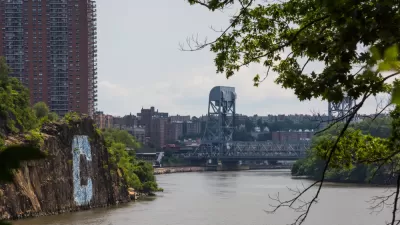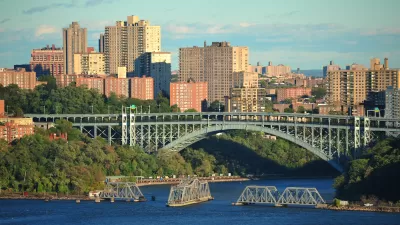A rezoning plan for the neighborhood of Inwood could take a critical step forward this week.

Obed Fulcar writes an opinion piece in support of a rezoning process for the Inwood neighborhood in the borough of Manhattan. Fulcar leads the community group Friends of Sherman Creek, which, in Fulcar's words, has been working for years to support a plan "to transform Inwood’s long-inaccessible eastern waterfront into a publicly accessible greenway for the entire neighborhood to enjoy."
According to Fulcar, later this week the New York City Council's Subcommittee on Zoning and Franchises will consider the de Blasio administration's rezoning plan for Inwood.
"There’s much at stake in this proposal, which was crafted over the past three years with the participation of dozens of community groups like ours and other local stakeholders," writes Fulcar. "It includes the creation of hundreds of units of affordable housing, preservation of rent-regulated housing stock, and well-crafted plans to keep many existing businesses in place."
That's not the part Fulcar, as a self-proclaimed park advocate, is most excited about. "[W]hat I find most exciting is its potential to transform the Sherman Creek area and the Harlem River waterfront into a beautiful “Malecón”—Spanish for an edge-water public space—and, at long last, the Sherman Creek Master Plan coming to fruition, with the opportunity to make it easy for the community to reach that long-neglected stretch of the waterfront," writes Fulcar.
Without naming anyone specifically, Fulcar notes opposition to the rezoning, and issues a strong endorsement of the plan.
FULL STORY: Rezoning would give us back our waterfront—and so much more

Alabama: Trump Terminates Settlements for Black Communities Harmed By Raw Sewage
Trump deemed the landmark civil rights agreement “illegal DEI and environmental justice policy.”

Planetizen Federal Action Tracker
A weekly monitor of how Trump’s orders and actions are impacting planners and planning in America.

The 120 Year Old Tiny Home Villages That Sheltered San Francisco’s Earthquake Refugees
More than a century ago, San Francisco mobilized to house thousands of residents displaced by the 1906 earthquake. Could their strategy offer a model for the present?

Indy Neighborhood Group Builds Temporary Multi-Use Path
Community members, aided in part by funding from the city, repurposed a vehicle lane to create a protected bike and pedestrian path for the summer season.

Congestion Pricing Drops Holland Tunnel Delays by 65 Percent
New York City’s contentious tolling program has yielded improved traffic and roughly $100 million in revenue for the MTA.

In Both Crashes and Crime, Public Transportation is Far Safer than Driving
Contrary to popular assumptions, public transportation has far lower crash and crime rates than automobile travel. For safer communities, improve and encourage transit travel.
Urban Design for Planners 1: Software Tools
This six-course series explores essential urban design concepts using open source software and equips planners with the tools they need to participate fully in the urban design process.
Planning for Universal Design
Learn the tools for implementing Universal Design in planning regulations.
Clanton & Associates, Inc.
Jessamine County Fiscal Court
Institute for Housing and Urban Development Studies (IHS)
City of Grandview
Harvard GSD Executive Education
Toledo-Lucas County Plan Commissions
Salt Lake City
NYU Wagner Graduate School of Public Service




























